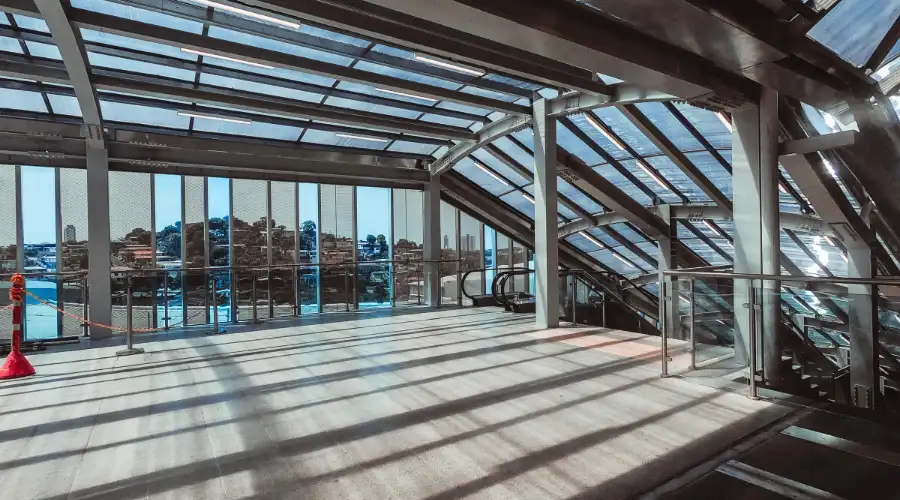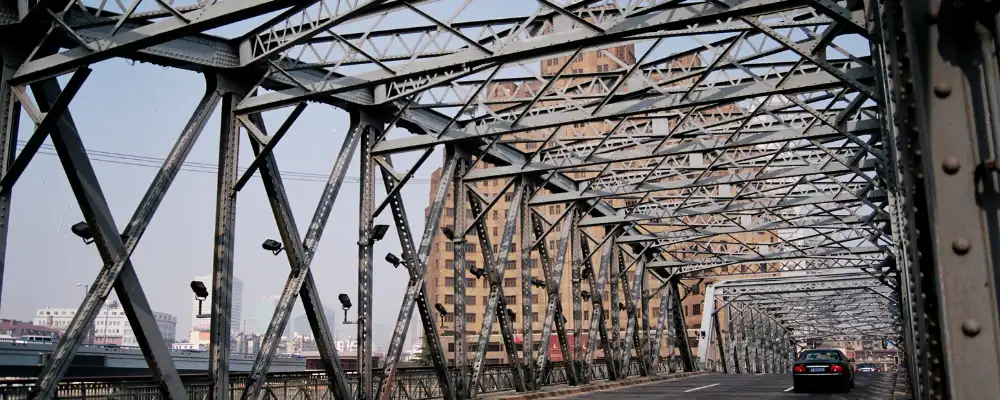In today’s construction industry, both structural and non-structural elements often utilise steel. Cold-formed steel is a vital construction material made with cold-working methods that enhance sustainability and support eco-friendly living. The technique is widely used in many parts of India and there is a wide range of shapes available in cold-formed steel. Steel elements undergo rolling, punching, and other processes to form the required structure for the production of these CFS components. To learn more about CFS, continue reading.
What are Cold-Formed Steel Structures?
Cold-formed steel structures are made from thin steel sheets that are less than 6 mm thick and are shaped at room temperature without applying any additional heat. In fact, cold-formed steel is shaped by pressing, rolling and similar processes, but not by heating. Common shapes produced are Z and C sections, angles and channels. Cold-formed steel structures are widely used in construction to enhance durability and stability. They are highly recommended for commercial buildings and residential spaces for framing trusses, walls and roofs, as they are easy to install and construct.
Manufacturing Process of CFS Components
The manufacturing process of CFS components are as follows:
- Material Loading: Steel coils are loaded onto the uncoiler, and prepared for further processing.
- Feeding and Tensioning: Feeders guide the steel strip into the line, while tensile structure keeps the strip flat and aligned during forming.
- Rolling Process: The strip is fed through a sequence of roll forming stands, which gradually shape it into the necessary CFS profile with extreme precision.
- Tandem Mill: Multiple stands work together to generate complicated forms while maintaining strength and precision.
- Exit Section and Coiling Line: The formed steel is cut to length or recoiled, according to the use, and then packaged and delivered.
The Characteristics of Cold-Formed Steel
High Durability and Strength
Cold-formed steel structures are lightweight and produced with high strength capacity for all the weight ratios. Most of the construction engineers opt for cold-formed steel for its high load-bearing capacity that does not require heavy foundations.
Safety and Fire Resistance
Cold-formed steel offers better fire resistance when compared to wood and other such materials. The addition of an extra layer enhances its fire safety, making it ideal for various applications in commercial, residential, and industrial constructions.
Sustainability
As it is a recyclable material, cold-formed steel is ideal for all construction projects that prioritise sustainability. The focus is on considering environmental needs that help reduce carbon emissions during construction.
Cost-effectiveness
When compared to concrete or hot steel, cold-formed steel is highly cost-effective, especially for large-scale projects. It reduces material waste and satisfies budget-friendly construction. As it is affordable, engineers often choose cold-formed steel instead of traditional materials.
Flexibility
Cold-formed steel can be transformed into different shapes and designs that permit excessive flexibility. It enhances creativity in roofs, walls, columns, facades, etc., with its design flexibility.
Hardness
The hardness test measures the steel’s resistance to deformation and wear. CFS is typically subjected to a Rockwell hardness test to ensure its durability and performance under stress. A consistent hardness level guarantees that the construction has uniform strength throughout. As per the National building Code and Indian Standards Code IS 7226 (1974), the following conditions must be met:
| Steel Designation | Hardness | |||
| Annealed | Annealed and Rerolled | |||
| HRB, Max | Equivalent HV, Max | HRC, Max | Equivalent HV, Max | |
| C40 | 83.4 | 160 | 28 | 290 |
| C55 | 85.0 | 165 | 35 | 350 |
| C70 | 87.9 | 175 | 35 | 350 |
| C80 | 91.6 | 190 | 35 | 350 |
| C85 | 91.6 | 190 | 35 | 350 |
| C98 | 94.8 | 205 | 35 | 350 |
| 120Cr35 | 97.5 | 220 | 35 | 350 |
| 110Cr35W2 | 97.5 | 220 | 35 | 350 |
Freedom From Defects
Surface defects like scales, rust, blisters, laminations, pitting and structural cracks and broken edges are all unacceptable in high quality CFS. Defect free materials improve the structural integrity and durability of structures.
Edge Conditions
Cold-formed steel edges are smooth and cut with consistent precision. Clean edges protect against injury while handling and ensure proper fit during assembly.
Rolling Tolerance
Rolling tolerance is the permitted variation in thickness and flatness. Tight rolling tolerances in CFS guarantee that components fit exactly in structural applications, enhancing stability and load-bearing capability. As per the Indian Standards Code IS 7226 (1974), the following tolerances are allowed:
| Thickness (mm) | Width Range (mm) | Tolerance on Width (mm) |
| Up to and including 1.6 | Up to 225 mm225 to 330 mm | 0.15 0.20 |
| Over 1.6 up to 3.0 | Up to 225 mm 225 to 330 mm | 0.20 0.25 |
| Mill Edge | Over 200 up to 330 mm | + 3.2 – 1.6 |
| Thickness Range (mm) | Width ≤ 225 mm (Tolerance ± mm) | Width > 225 mm and ≤ 330 mm (Tolerance ± mm) |
| Up to 0.15 | ± 0.015 | ± 0.020 |
| 0.15 to 0.40 | ± 0.020 | ± 0.030 |
| 0.40 to 0.73 | ± 0.030 | ± 0.040 |
| 0.74 to 1.20 | ± 0.040 | ± 0.050 |
| 1.21 to 3.00 | ± 0.050 | ± 0.060 |
Surface Finish
A smooth and clean surface is essential for corrosion resistance and aesthetic value. A good finish on cold-formed steel also guarantees better and more protective coatings.
Packing
CFS sections should be properly stacked and packed during transport and storage to lower the chance of damage. Protective wraps and strips guarantee that they remain safe during transportation.
Marking
The cold-formed sheet is clearly identified with grade and batch number. This labeling technique allows for easy identification and traceability, which is crucial during installation and inspection.
Advantages of Cold-Formed Steel Structures

There are various benefits of cold formed steel structures. These include:
- Resistance to Warping: The ability of cold-formed steel to resist warping is its greatest benefit. CFS maintains its dimensional stability in contrast to wood that can shrink as a result of moisture and temperature changes. This lowers the possibility of misaligned walls by ensuring the building maintains its structural integrity over time. CFS provides peace of mind for projects in humid or variable climates because of its dependable form retention.
- Termites Resistance: Termite infestation causes major damage during the winter season. Infestations can cause expensive repairs and safety risks in wood constructions. However, termites and other pests cannot harm cold-formed steel, so there is no need for continuous pest control or chemical treatments.
- Fire Resistance: Safety is a major concern in construction and CFS has great fire resistance. Steel does not burn and reduces the spread of flame in the event of a fire. Cold-formed steel framing has the potential to decrease fire insurance costs and comply with severe fire safety codes for urban or multi-family housing developments.
- Recyclability: Sustainability is coming to the fore in construction, and cold-formed steel leads the way on the environmental front. CFS is 100% recyclable with no diminution in quality. It can be recycled at the end of the building’s life cycle, thus minimising construction waste and the need for virgin materials. Recycling steel can also help earn LEED certification and other green building ratings.
- Consistent Quality: Cold-formed steel is produced in controlled, exacting conditions from high-strength steel sheets. This creates even dimensions and the finished product has a high level of consistency and reliability. Prefabrication of the components reduces errors on-site and accelerates on-site assembly. It leads to greater overall project efficiency.
- Strength Tolerance: The cold-formed steel has outstanding structural strength. It has a high strength-to-weight ratio and it ensures high load-bearing capacity without adding unnecessary weight.
- Improved Surface Finish: Cold forming provides a smooth and clean surface finish. This makes the components easier to paint, polish or finish in other ways. It improves both aesthetic appeal and corrosion resistance.
- Tight Tolerance: Cold-formed steel components are made with high dimensional accuracy. This tighter tolerance improves assembly quality and allows for better integration with other construction materials or systems.
Applications of Cold-Formed Steel Structures
Industrial Uses
Cold-formed steel structures are widely used in industrial projects like framing for tracks, warehouses, sheds, and light structures. Cold-formed steel can comply with various designs and structures while providing high durability and strength. It has a good capacity to withstand heavy loads and harsh weather with its corrosion-free traits.
Residential Uses
The best alternative to wood for framing buildings is steel, especially cold-formed steel, which is lightweight and easy to handle. As it is cost-effective and resistant to warping, rot, and termites, it is ideal for framing houses, especially large-scale or modular residences.
Prefabricated Construction
Cold-formed steel is widely used in modular projects and prefabricated construction sectors. The materials and structures are formed in the factory (off-site) and then brought to the location (on-site) to assemble it. Cold-formed steel perfectly fits this method of structural formation that improves efficiency and decreases negative environmental impacts.
Design Considerations for Cold-Formed Steel Structures
- Strength Requirements: Cold-formed steel has a higher yield strength due to strain hardening during manufacture, making it suitable for lightweight structural applications. Hot-rolled steel has more ductility and is therefore favoured for use in heavy-duty buildings.
- Cost Constraints: Hot-rolled steel is typically less expensive for large-scale projects due to decreased production costs. Cold-formed parts can be more costly due to additional processing, but they may result in cost savings through lightweight construction.
- Aesthetics: Cold-formed sections provide smoother surfaces and more precise shapes. This is ideal for visible architectural applications.
- Tolerances and Precision: Cold-formed steel has narrower dimensional tolerances, which are ideal for precision-built components. Cooling may cause slight dimensional differences in hot-rolled parts.
- Environmental Conditions: The cold-formed steel may require protective coatings to work better in all environmental conditions, especially in regions with high humidity levels.
- Lead Time: Cold formed pieces are often readily available in standard sizes, which reduces procurement time.
- Regulatory Requirements: Local codes and standards may require the use of one type over another based on structural safety and fire resistance.
Wrapping Up
Cold-formed steel like Cold Rolled Steel is a significant component in today’s construction industry as it doesn’t require heat to be shaped into the right form. It is made with high durability, and strength, and is lightweight. Moreover, the fabrication process involves rolling, pressing, punching, and fitting materials specifically for residential and commercial building purposes. Cold-formed steel offers several advantages, including durability, sustainability, and high efficiency. As constructive designs and technology evolve, CFS is ready to play a major role in shaping a sustainable environment.

